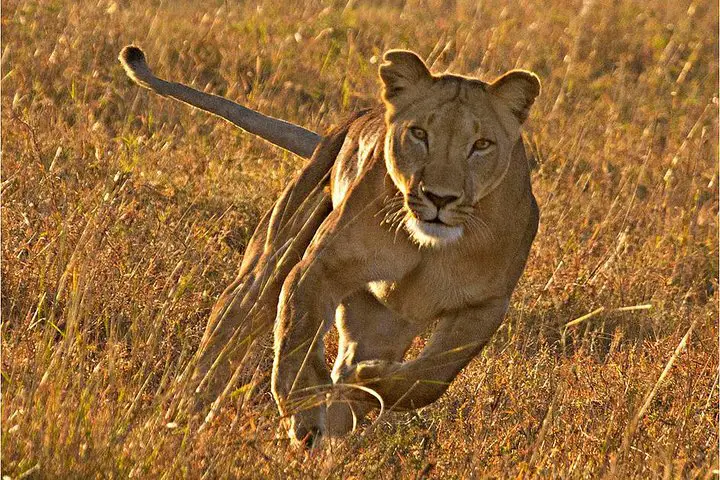Among the many fascinating creatures that grace the African wilderness, the Tsavo lions hold a particular allure. These magnificent big cats, found in the Tsavo region of Kenya, boast unique characteristics that set them apart from their counterparts in other parts of Africa.
From their infamous history as ‘man-eaters’ to their distinct physical attributes and complex social structures, the Tsavo lions are a subject of intrigue and constant study for researchers and wildlife enthusiasts alike.
Notable Maneless Males
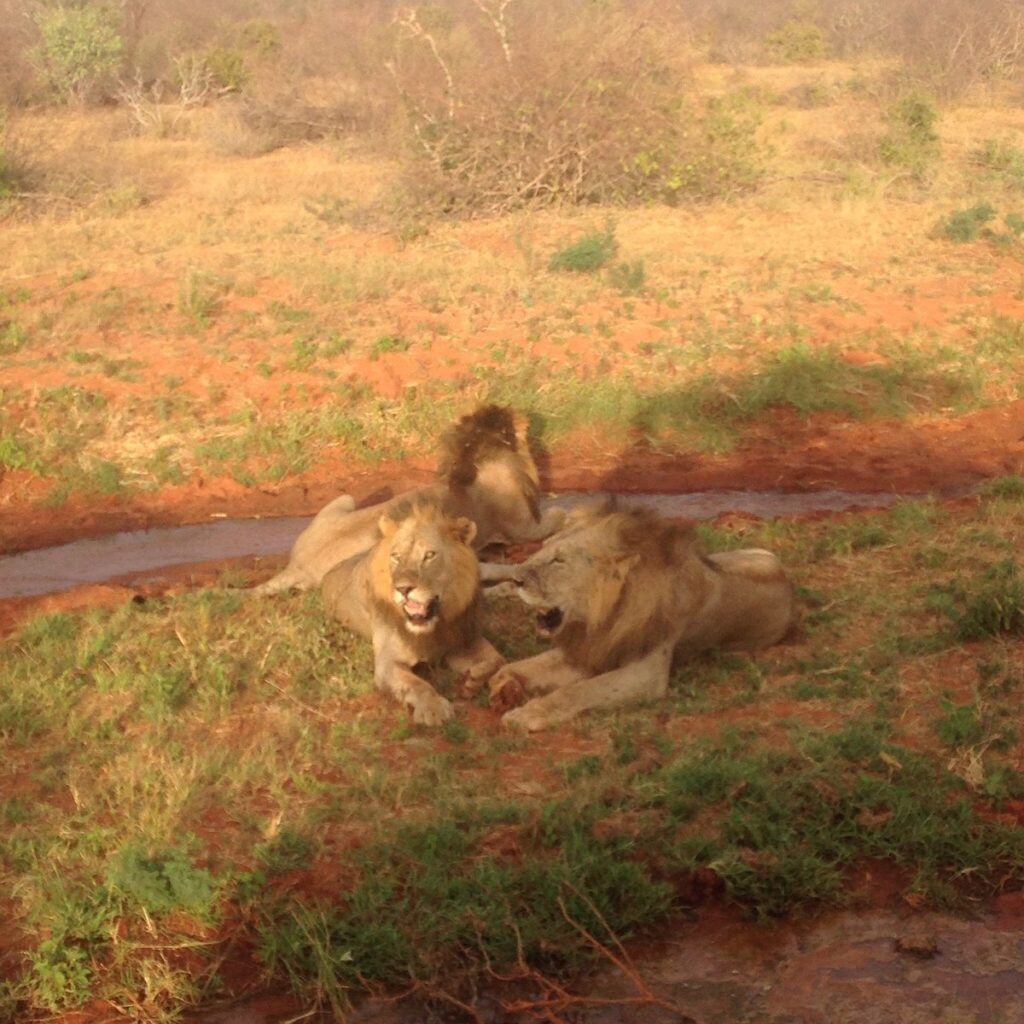
The maneless lions of Tsavo represent one of the most intriguing mysteries of the animal kingdom. They defy the iconic image of the male lion with a thick, flowing mane.
The most distinctive physical feature of Tsavo male lions is their lack of a mane. While male lions in other parts of the world sport a thick mane around their head and neck, the male lions in Tsavo are generally maneless or have very short, thin manes. They still have the robust and muscular build typical of male lions, but the absence of a mane gives them a sleeker appearance.
There are several theories about why Tsavo lions lack manes. Some researchers suggest it could be due to the region’s hot and arid climate, as a thick mane could be a disadvantage in such conditions. Other theories propose a genetic basis, with manelessness being a trait that has evolved in this particular population and is passed down from generation to generation. Some research indicates that testosterone levels might affect mane growth and Tsavo lions could have lower testosterone levels, but more research is needed to confirm this theory.
The lack of a mane might have some advantages for Tsavo lions. It could potentially help them move more easily through the region’s thick brush and thorny vegetation. It might also make them less conspicuous to their prey. Some research has even suggested that maneless males may be more successful in fights, as they present fewer easy handholds for their opponents.
The lack of a mane doesn’t seem to impact the Tsavo lions’ social structure or breeding success. They still live in prides with a social structure similar to other lion populations, and maneless males are successful in breeding.
The maneless lions of Tsavo continue to be a source of fascination and study for scientists. Their distinctive appearance adds to the rich diversity of lion populations across Africa and reminds us of the incredible variety within the animal kingdom. While their manelessness might seem unusual, it represents a successful adaptation to their unique environment, emphasizing nature’s capacity for flexibility and innovation.
The ‘Man-Eaters of Tsavo’
One of the most fascinating and chilling aspects of the Tsavo lions is their reputation as ‘man-eaters.’ This reputation comes primarily from a series of events in 1898 when two maneless male lions reportedly killed and ate between 28 and 135 Indian and African workers constructing the Kenya-Uganda railway. Colonel J.H. Patterson, who eventually killed the two lions, chronicled these events in his book “The Man-Eaters of Tsavo.”
Various theories have been proposed to explain this unusual behavior, ranging from dental disease making it painful for the lions to take their usual prey, to a shortage of natural prey due to a rinderpest epidemic among local ungulates. While man-eating is generally rare among lions, this episode has added an element of mystery and fear to the legend of the Tsavo lions.
Unique Hunting Strategies
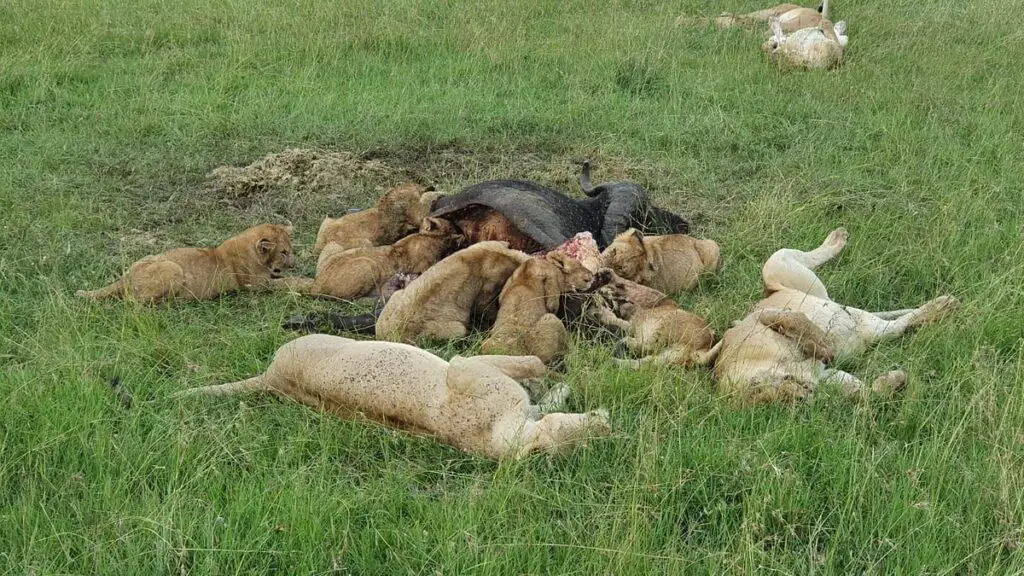
Tsavo lions typically form smaller hunting groups than their counterparts in other regions. This could be due to the arid environment of the Tsavo region, which has fewer water sources and less dense vegetation, leading to a more scattered distribution of prey.
Tsavo lions, like other lions, are opportunistic hunters. This means they’ll hunt whatever prey is available, from small rodents and reptiles to large ungulates like zebras, buffalo, and even elephants in certain circumstances. The Tsavo lions have developed a broad diet in response to the varied and sometimes scarce availability of prey in their environment.
The Tsavo lions, like other lion populations, primarily use stalking and ambush techniques when hunting. They take advantage of their natural tawny coloration to blend into the surrounding vegetation, creeping close to their prey before launching a quick and powerful attack.
Lions are known for their night hunting skills, and Tsavo lions are no exception. Their exceptional night vision gives them an advantage over many of their prey species during the darker hours. Hunting under the cover of darkness also helps them avoid the daytime heat in their arid habitat.
Despite the generally smaller size of their hunting groups, Tsavo lions display cooperative hunting behavior. This involves encircling their prey or driving it towards other members of the group in a pincer-like movement, increasing the chances of a successful hunt.
It’s worth noting that while the hunting strategies of Tsavo lions share many similarities with those of other lion populations, their tactics reflect specific adaptations to their unique environment.
Tsavo Lions Have Unique Physical Characteristics
The size of Tsavo lions can vary, with males typically being larger than females. Adult males usually weigh between 150-225 kilograms (330-500 lbs), while females generally weigh between 120-180 kilograms (265-400 lbs). Despite this size difference, both males and females are formidable predators.
Tsavo lions, like other African lions, have a short, tawny-colored coat that blends into the surrounding grasslands, helping them stay camouflaged while hunting. Some Tsavo lions may have slightly darker or lighter coats, but the variation is typically within the same tawny range.
One of the unique physical characteristics of the Tsavo lions is the maneless males. While male lions in other parts of Africa are recognized by their thick, often dark manes, male Tsavo lions are usually maneless or have very light, sparse manes.
The physical characteristics of Tsavo lions reflect several adaptations to their harsh environment. Their lack of a mane might be a response to the hot, thorny environment, and their tawny coat helps them blend into the savanna landscape, providing an advantage during hunting.
Lion Cubs are Reared Together
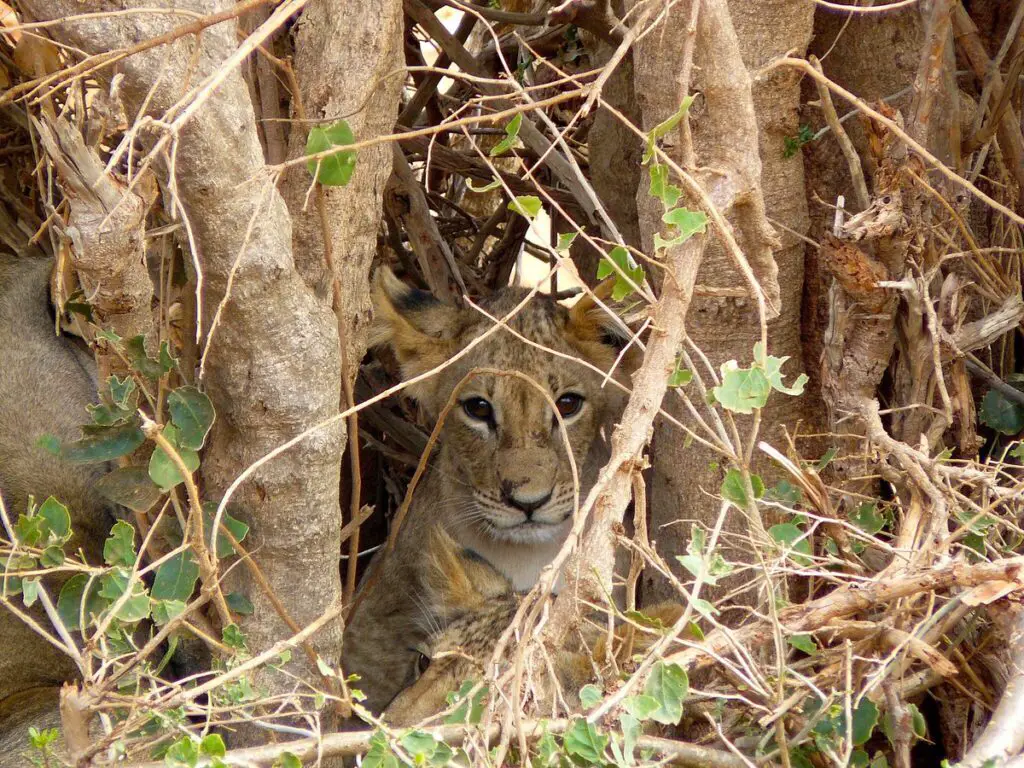
One of the most intriguing aspects of lion social behavior is the communal rearing and care of cubs. Here’s a closer look at how lion cubs are reared together in a pride:
Female lions in a pride often synchronize their reproductive cycles and give birth around the same time. This results in a group of cubs of similar age, which are collectively cared for by the pride’s lionesses.
The lionesses in a pride will often nurse each other’s cubs, a behavior known as allo-nursing or communal nursing. This ensures that all cubs have a chance at survival, even if their biological mother is unable to provide milk.
Lionesses are fiercely protective of their cubs and will guard them against threats from outside the pride. Male lions within the pride will also defend the cubs against rival males that may attempt to take over the pride and kill existing cubs.
Young cubs learn essential survival skills through play. This often involves mock battles with their siblings or other cubs in the pride, which helps them develop their hunting and fighting abilities. Lionesses also teach their cubs how to hunt by bringing back live prey for them to practice on.
By being reared together, cubs develop strong social bonds with their siblings and other pride members. These bonds play a crucial role in maintaining the pride’s social structure as the cubs grow up.
Despite the communal care, lion cub mortality is high, often due to starvation, predation by other large carnivores, and infanticide by rival males. Only about half of all cubs survive to adulthood.
The communal rearing of cubs is a remarkable example of the cooperative behavior found in lion prides. It ensures the survival and wellbeing of the next generation and helps maintain the pride’s social cohesion. This is one of the many ways in which lions have adapted to the challenges of their environment and underscores the complexity of their social behavior.
They Start Off Spotty
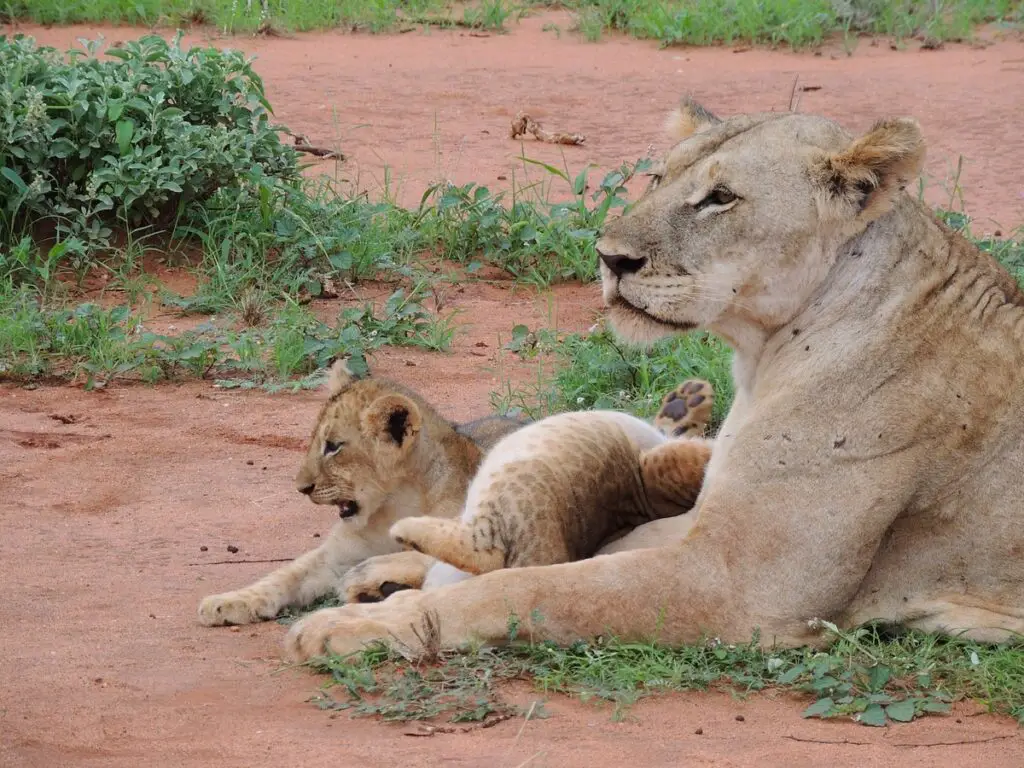
When lion cubs are born, they have a light, spotted coat. These spots are thought to help camouflage the cubs in their den, protecting them from potential predators.
As the cubs grow older, these spots start to fade. By the time they reach adulthood, most lions have a uniformly colored, tawny coat. However, some adult lions, especially females, may still retain a few spots on their underparts or the backs of their ears.
The primary purpose of the spots is believed to be camouflage. When cubs are small, they stay hidden in dense vegetation while their mothers go off to hunt. The spots help break up their silhouette and blend them into the dappled shadows, protecting them from potential predators.
Many other species of wild cats, including leopards and cheetahs, also have spotted coats. However, these spots remain throughout their lives, serving as an effective camouflage in a variety of habitats. In the case of lions, as they grow older and stronger, and their lifestyle becomes more social and less reliant on stealth, the need for such camouflage decreases.
The spots on lion cubs are a fascinating aspect of their early development and are a testament to the importance of camouflage for survival in the wild. As they grow and their lifestyle changes, these spots fade, giving way to the distinctive, tawny coat of the adult lion.
Tsavo Lions Have a Polygynous Mating System
The Tsavo lions, like most other lion populations, follow a polygynous mating system. Polygyny refers to a mating system in which a single male mates with multiple females. In the case of lions, this typically occurs within the context of a lion pride, which consists of one or more males and several females.
The social structure of a lion pride is centered around its females, who are often related to each other (sisters, mothers, daughters). Males will compete for control of a pride, and the dominant male(s) will have breeding rights to the females within that pride.
Male tenure in a pride is often short, lasting on average between 2-3 years. This is due to the intense competition among male lions for control of prides. Once a male or coalition of males (usually brothers or close relatives) takes over a pride, they will attempt to mate with the receptive females.
Interestingly, female lions within a pride often synchronize their reproductive cycles. This leads to a cohort of cubs that are of a similar age, which are communally raised by the lionesses in the pride. While this doesn’t mean the cubs have the same father, it does increase the chances of survival for all cubs, as communal care ensures better protection and feeding opportunities.
When a new male or group of males takes over a pride, they often commit infanticide, killing the existing cubs in the pride that are not their own. This is a brutal strategy to bring the lionesses back into estrus more quickly, allowing the new males to sire their own offspring and pass on their genes.
The polygynous mating system of the Tsavo lions reflects the complex social dynamics of lion prides. While it is often fraught with challenges, this system has evolved over millennia and is fundamental to the survival and continuity of the lion populations.
Lions are Big Eaters
Lions are among the largest predators on land, and their substantial body size requires a high energy intake. Adult male lions can weigh up to 225 kilograms (500 lbs) and females up to 180 kilograms (400 lbs). To maintain their mass and support their biological functions, lions need to consume a significant amount of meat.
Hunting involves a lot of physical exertion. Although lions are strategic hunters and conserve energy by stalking their prey before launching a quick and powerful attack, the process still requires a significant amount of energy. Additionally, defending their territory and their kills from other predators is also a strenuous activity.
Unlike humans, lions don’t eat on a daily schedule. They eat when they make a kill, which may not happen every day. Because of the unpredictability of their meals, when they do eat, they consume as much as they can to sustain themselves during periods when food is scarce.
Lions live in prides and share their kills with other members. Therefore, a single kill must be enough to feed multiple mouths. This communal eating means that they need to take down larger prey or eat more frequently.
Lions, being carnivores, require a diet rich in protein and fat, which they get from the meat they consume. The large quantities of meat they eat help them meet their nutritional needs for growth, reproduction, and overall health.
Lions have the capacity to eat up to 25% of their body weight in a single meal. This gorging behavior allows them to take full advantage of the availability of food when it’s present, storing excess calories to use during leaner times.
They Hunt Mostly at Night
Lions are known as nocturnal hunters, preferring to hunt under the cover of darkness. The dark provides a cloak of invisibility for lions, allowing them to stalk their prey without being easily detected. Their tawny-colored fur further aids in blending with the surroundings under low light.
Many of the prey species that lions target are less active at night, which can make them more vulnerable to predation. Additionally, some prey animals have poorer night vision than lions, giving the lions an advantage.
Lions are not very efficient at regulating their body temperature. Hunting during the coolness of the night helps them avoid the energy-sapping heat of the African sun.
Hunting at night can help lions avoid competition with other large carnivores like hyenas, which are often active during twilight hours. Additionally, lions can take over kills made by other predators under the cover of darkness.
Lions spend a significant portion of their day resting (up to 20 hours) to conserve energy. Activity peaks during the night, not only for hunting but also for social interactions and mating.
Lions’ eyes are adapted for hunting in low light conditions. They have a high number of rod cells and a structure called tapetum lucidum in their eyes that reflects light back through the retina, improving their ability to see in the dark. This superior night vision plays a significant role in their nocturnal hunting success.
Lions Are The Only Cats Who Roar Together
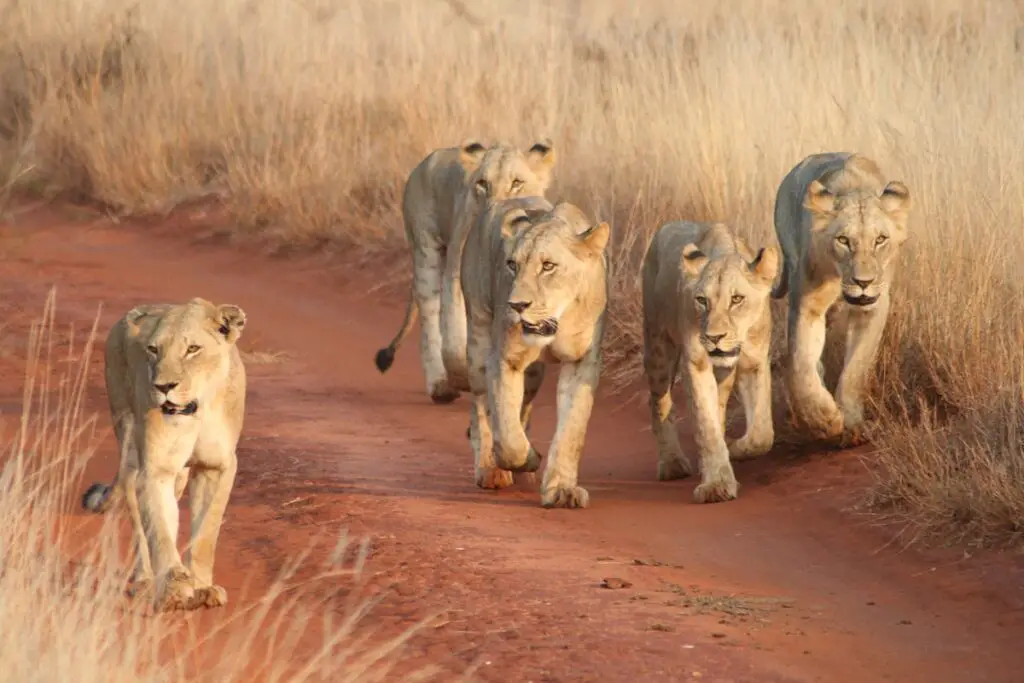
Roaring is a significant part of a lion’s communication system, and uniquely among the animal kingdom, lions often roar together in a behavior known as “chorusing.” Here’s more information about this unique aspect of lion behavior:
Lions are the most social of all big cats, living in groups called prides. The act of chorusing or roaring together strengthens the bond within the pride and helps maintain social cohesion. It is a communal activity that fosters unity and helps each lion identify with its own pride.
A lion’s roar is a powerful sound that can be heard up to 8 kilometers (5 miles) away. When lions roar together, the collective noise is even louder and can serve as an impressive show of strength to deter rival prides or lone lions from encroaching on their territory.
Roaring together can help in coordinating the pride’s movements. For instance, if part of the pride gets separated, a group roar can help the missing members locate the rest of the pride.
When a group of lions roars together, it becomes difficult for other animals to pinpoint the exact location of each individual lion. This can be useful during hunts, where creating confusion can provide an advantage.
Some studies suggest that lions’ group roaring may trigger a communal hunting event. Roaring together can rally the pride and sync their readiness for an upcoming hunt.
The behavior of lions roaring together is unique in the animal kingdom and demonstrates their complex social structure and communication system. The communal roaring not only fosters strong social bonds but also serves practical purposes in the lions’ survival strategies.

